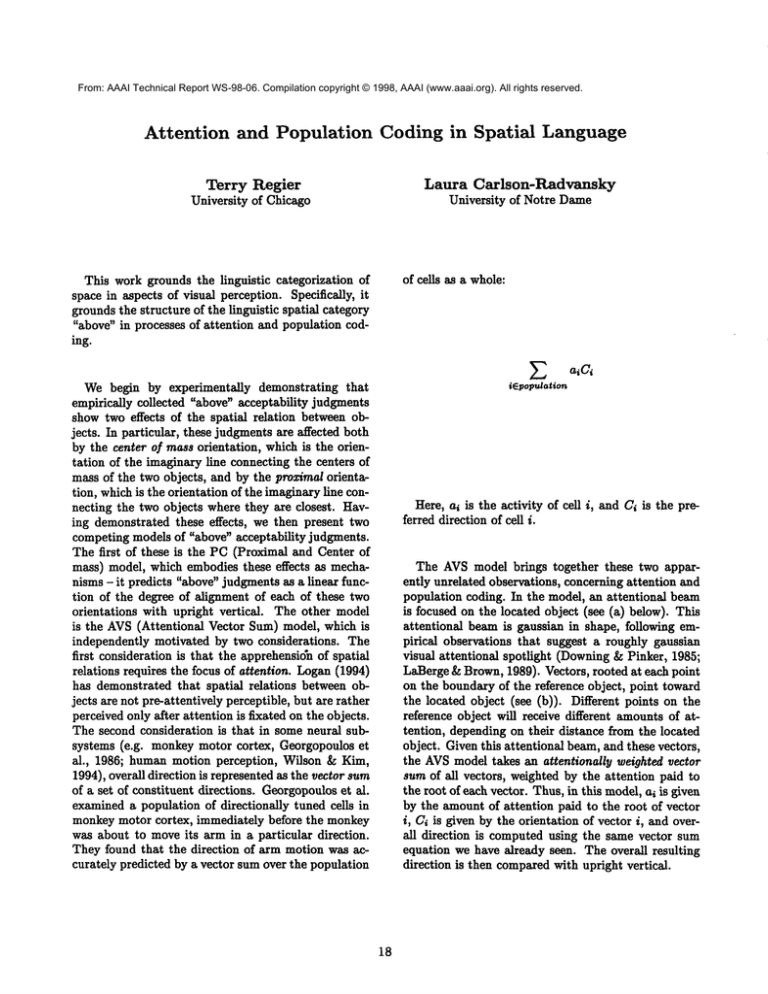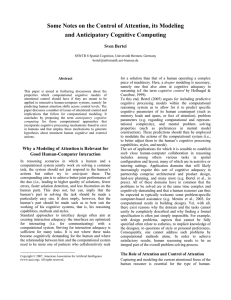
From: AAAI Technical Report WS-98-06. Compilation copyright © 1998, AAAI (www.aaai.org). All rights reserved.
Attention
and Population
Coding in Spatial
Language
Laura Carlson-Radvansky
Terry
Regier
University of Chicago
University of Notre Dame
This work grounds the linguistic categorization of
space in aspects of visual perception. Specifically, it
grounds the structure of the linguistic spatial category
"above" in processes of attention and population coding.
of cells as a whole:
We begin by experimentally
demonstrating that
empirically collected "above" acceptability judgments
show two effects of the spatial relation between objects. In particular, these judgments are affected both
by the center of mass orientation, which is the orientation of the imaginary line connecting the centers of
mass of the two objects, and by the prozimal orientation, whichis the orientation of the imaginary line connecting the two objects where they are closest. Having demonstrated these effects, we then present two
competing models of "above" acceptability judgments.
The first of these is the PC (Proximal and Center of
mass) model, which embodies these effects as mechanisms - it predicts "above" judgments as a linear function of the degree of alignment of each of these two
orientations with upright vertical. The other model
is the AVS(Attentional Vector Sum) model, which
independently motivated by two considerations.
The
first consideration is that the apprehension of spatial
relations requires the focus of attention. Logan (1994)
has demonstrated that spatial relations between objects are not pre-attentively perceptible, but are rather
perceived only after attention is fixated on the objects.
The second consideration is that in some neural subsystems (e.g. monkey motor cortex, Georgopoulos et
al., 1986; human motion perception, Wilson & Kim,
1994), overall direction is represented as the vector sum
of a set of constituent directions. Georgopouloset al.
examined a population of directionally tuned cells in
monkey motor cortex, immediately before the monkey
was about to move its arm in a particular direction.
They found that the direction of arm motion was accurately predicted by a vector sum over the population
Here, ai is the activity of cell i, and Ci is the preferred direction of cell i.
The AVSmodel brings together these two apparently unrelated observations, concerning attention and
population coding. In the model, an attentional beam
is focused on the located object (see (a) below).
attentional beam is gaussian in shape, following empirical observations that suggest a roughly gaussian
visual attentional spotlight (Downing& Pinker, 1985;
LaBerge & Brown, 1989). Vectors, rooted at each point
on the boundary of the reference object, point toward
the located object (see (h)). Different points on
reference object will receive different amountsof attention, depending on their distance from the located
object. Given this attentional beam, and these vectors,
the AVSmodel takes an attentionally weighted vector
sum of all vectors, weighted by the attention paid to
the root of each vector. Thus, in this model, ai is given
by the amount of attention paid to the root of vector
i, Ci is given by the orientation of vector i, and overall direction is computed using the same vector sum
equation we have already seen. The overall resulting
direction is then comparedwith upright vertical.
18
- att~tir~al
field
TR
.. ,,’,..... --..;]
~1
LM
(a)
(b)
Weshow that the AVSmodel exhibits the two eiTects
that were deliberately built into the PCmodel; that it
provides a closer fit to the data than the PC model or
related competitors; and that it makes novel, substantiated predictions concerning the effects of distance on
"above" judgments. We draw two conclusions: that
the structure of linguistic spatial categories may be
explained in terms of independently motivated attentional and perceptual processes; and that effects need
not be directly reflective of mechanisms.
References
Downing,C. and Pinker, S. (1985). The spatial structure of visual attention. In M. Posner and O. Marin
(eds.) A~ention and Pe~ormanc~ XI, Lawrence Erlbaum, Hillsdale, N J, pp. 171-187.
Georgopoulos, A. P., Schwartz, A. B., and Kettner, R.
E. (1986). Neuronal population coding of movement
direction. Science, 223, 1416-1419.
LaBerge, D. and Brown, V. (1989). Theory of attentional operations in shape identification. Psychological
Revie~o, 96, 101-124.
Logan, G. D. (1994). Spatial attention and the apprehension of spatial relations. Journal of Expe~mental Psychology: HumanPerception £.4 Performance, 20,
1015-1036.
Wilson, H. R. and Kim, J. (1994). Perceived motion
the vector sum direction. Vision Research, 34, 18351842.
19




